Note
Access to this page requires authorization. You can try signing in or changing directories.
Access to this page requires authorization. You can try changing directories.
In this article, you learn how to integrate Check Point Infinity Portal with Microsoft Entra ID. When you integrate Check Point Infinity Portal with Microsoft Entra ID, you can:
- Control in Microsoft Entra ID who has access to Check Point Infinity Portal.
- Enable your users to be automatically signed-in to Check Point Infinity Portal with their Microsoft Entra accounts.
- Manage your accounts in one central location.
Prerequisites
The scenario outlined in this article assumes that you already have the following prerequisites:
- A Microsoft Entra user account with an active subscription. If you don't already have one, you can Create an account for free.
- One of the following roles:
- Check Point Infinity Portal single sign-on (SSO) enabled subscription.
Scenario description
In this article, you configure and test Microsoft Entra SSO in a test environment.
Check Point Infinity Portal supports SP initiated SSO.
Check Point Infinity Portal supports Just In Time user provisioning.
Note
Identifier of this application is a fixed string value so only one instance can be configured in one tenant.
Add Check Point Infinity Portal from the gallery
To configure the integration of Check Point Infinity Portal into Microsoft Entra ID, you need to add Check Point Infinity Portal from the gallery to your list of managed SaaS apps.
- Sign in to the Microsoft Entra admin center as at least a Cloud Application Administrator.
- Browse to Entra ID > Enterprise apps > New application.
- In the Add from the gallery section, type Check Point Infinity Portal in the search box.
- Select Check Point Infinity Portal from results panel and then add the app. Wait a few seconds while the app is added to your tenant.
Alternatively, you can also use the Enterprise App Configuration Wizard. In this wizard, you can add an application to your tenant, add users/groups to the app, assign roles, and walk through the SSO configuration as well. Learn more about Microsoft 365 wizards.
Configure and test Microsoft Entra SSO for Check Point Infinity Portal
Configure and test Microsoft Entra SSO with Check Point Infinity Portal using a test user called B.Simon. For SSO to work, you need to establish a link relationship between a Microsoft Entra user and the related user in Check Point Infinity Portal.
To configure and test Microsoft Entra SSO with Check Point Infinity Portal, perform the following steps:
- Configure Microsoft Entra SSO - to enable your users to use this feature.
- Create a Microsoft Entra test user - to test Microsoft Entra single sign-on with B.Simon.
- Assign the Microsoft Entra test user - to enable B.Simon to use Microsoft Entra single sign-on.
- Configure Check Point Infinity Portal SSO - to configure the single sign-on settings on application side.
- Create Check Point Infinity Portal test user - to have a counterpart of B.Simon in Check Point Infinity Portal that's linked to the Microsoft Entra representation of user.
- Test SSO - to verify whether the configuration works.
Configure Microsoft Entra SSO
Follow these steps to enable Microsoft Entra SSO.
Sign in to the Microsoft Entra admin center as at least a Cloud Application Administrator.
Browse to Entra ID > Enterprise apps > Check Point Infinity Portal > Single sign-on.
On the Select a single sign-on method page, select SAML.
On the Set up single sign-on with SAML page, select the pencil icon for Basic SAML Configuration to edit the settings.
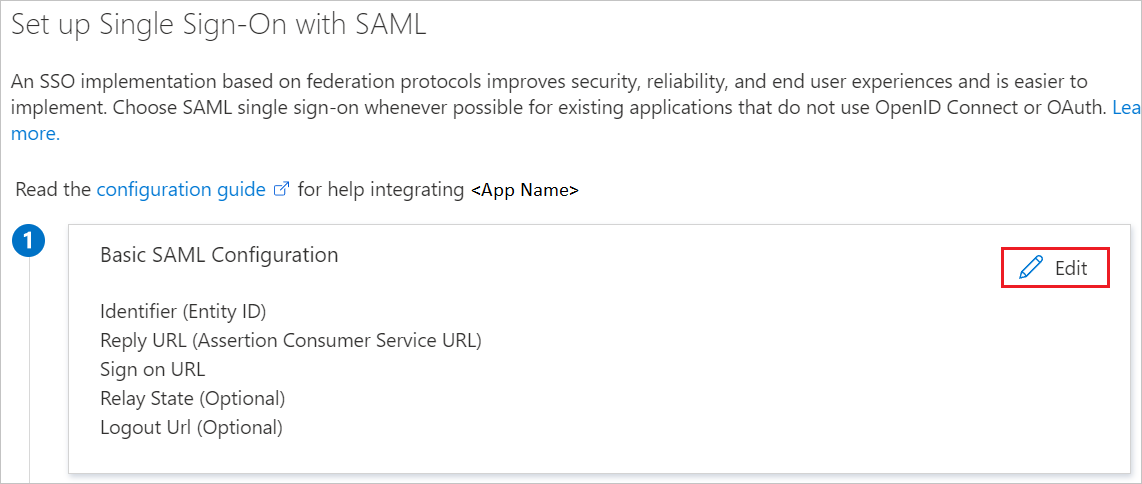
On the Basic SAML Configuration section, perform the following steps:
a. In the Identifier text box, type one of the following values:
Environment Identifier EU/US cloudinfra.checkpoint.comAP ap.portal.checkpoint.comb. In the Reply URL text box, type one of the following URLs:
Environment Reply URL EU/US https://portal.checkpoint.com/AP https://ap.portal.checkpoint.com/c. In the Sign on URL text box, type one of the following URLs:
Environment Sign on URL EU/US https://portal.checkpoint.com/AP https://ap.portal.checkpoint.com/On the Set up single sign-on with SAML page, in the SAML Signing Certificate section, find Federation Metadata XML and select Download to download the certificate and save it on your computer.

On the Set up Check Point Infinity Portal section, copy the appropriate URL(s) based on your requirement.

There are two ways for authorizing users:
Configure Check Point Infinity Portal application user roles in Azure portal
Configure Check Point Infinity Portal application user roles in Check Point Infinity Portal
Configure Check Point Infinity Portal application user roles in Azure portal
In this section, you create Admin and Read-Only roles.
From the left pane in the Azure portal, select App Registration, select All applications, and then select the Check Point Infinity Portal application.
From the left pane, select App roles, select Create app role and follow these steps:
a. In the Display name field, enter Admin.
b. In the Allowed member types, choose Users/Groups.
c. In the Value field, enter admin.
d. In the Description field, enter Check Point Infinity Portal Admin role.
e. Make sure that the enable this app role option is selected.
f. Select Apply.
g. Select Create app role again.
h. In the Display name field, enter Read-Only.
i. In the Allowed member types, choose Users/Groups.
j. In the Value field, enter readonly.
k. In the Description field, enter Check Point Infinity Portal Admin role.
l. Make sure that the enable this app role option is selected.
m. Select Apply.
Configure Check Point Infinity Portal application user roles in Check Point Infinity Portal
This configuration is applied only to the groups assigned to the Check Point Infinity Portal application in Microsoft Entra ID.
In this section, you’ll create one or more User Groups which will hold the Global and Service roles for the relevant Microsoft Entra groups.
- Copy the ID of the assigned group for use with the Check Point Infinity Portal User Group.
- For User Group configuration, refer to the Infinity Portal Admin Guide.
Create and assign Microsoft Entra test user
Follow the guidelines in the create and assign a user account quickstart to create a test user account called B.Simon.
Configure Check Point Infinity Portal SSO
Log in to your Check Point Infinity Portal company site as an administrator.
Navigate to Global Settings > Account Settings and select Define under SSO Authentication.
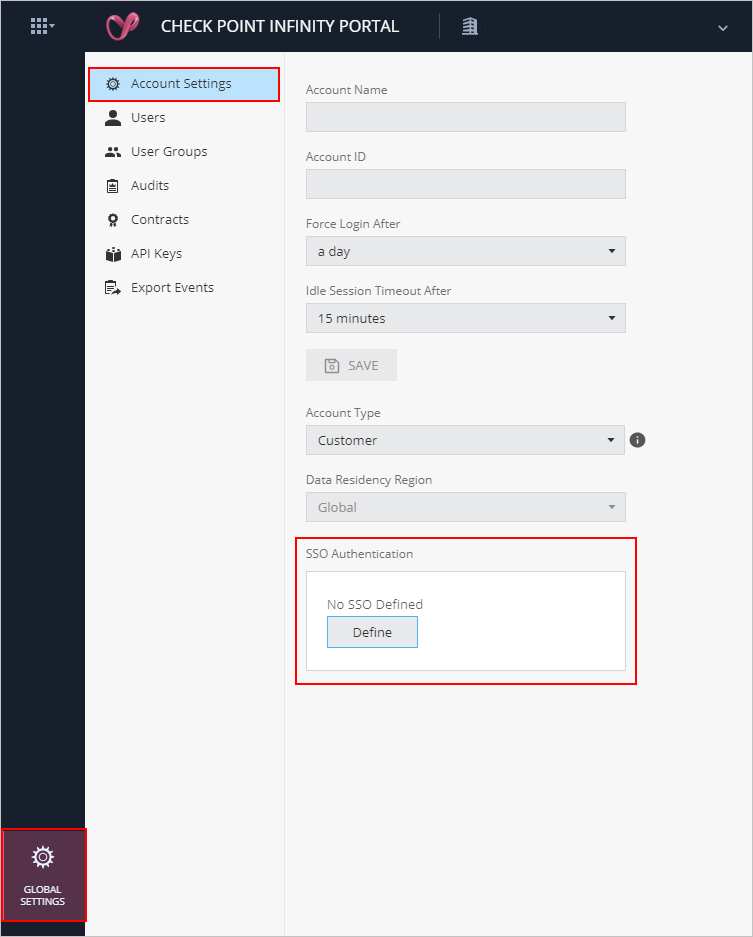
In the SSO Authentication page, select SAML 2.0 as an IDENTITY PROVIDER and select NEXT.
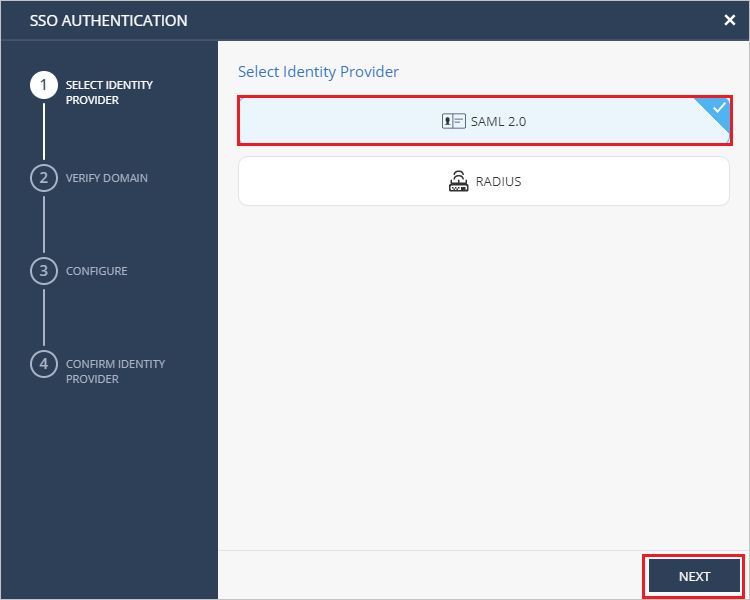
In the VERIFY DOMAIN section, perform the following steps:
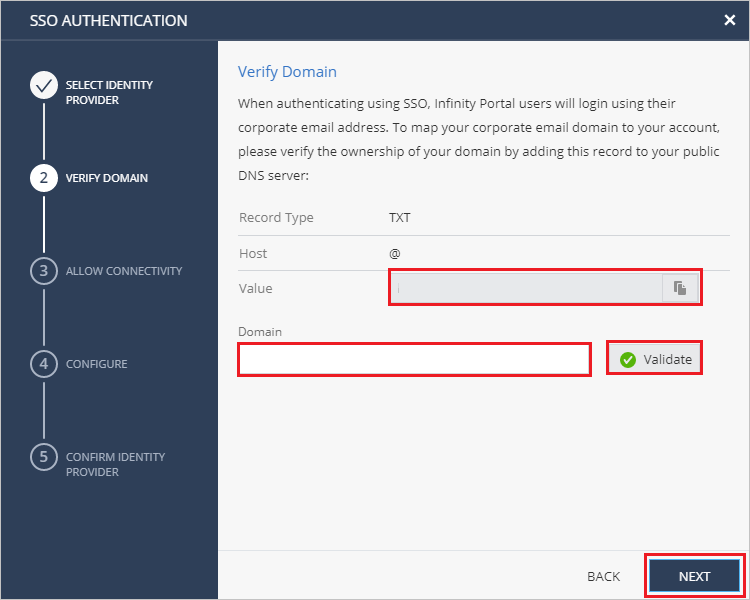
a. Copy the DNS record values and add them to the DNS values in your company DNS server.
b. Enter your company’s domain name in the Domain field and select Validate.
c. Wait for Check Point to approve the DNS record update, it might take up to 30 minutes.
d. Select NEXT once the domain name is validated.
In the ALLOW CONNECTIVITY section, perform the following steps:

a. Copy Entity ID value, paste this value into the Microsoft Entra Identifier text box in the Basic SAML Configuration section.
b. Copy Reply URL value, paste this value into the Reply URL text box in the Basic SAML Configuration section.
c. Copy Sign-on URL value, paste this value into the Sign on URL text box in the Basic SAML Configuration section.
d. Select NEXT.
In the CONFIGURE section, select Select File and upload the Federation Metadata XML file which you have downloaded and select NEXT.
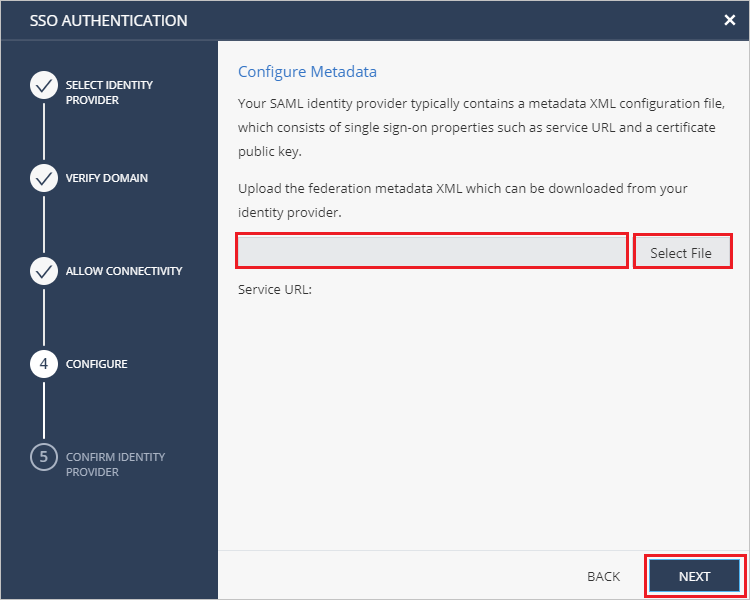
In the CONFIRM IDENTITY PROVIDER section, review the configurations and select SUBMIT.

Create Check Point Infinity Portal test user
In this section, a user called Britta Simon is created in Check Point Infinity Portal. Check Point Infinity Portal supports just-in-time user provisioning, which is enabled by default. There's no action item for you in this section. If a user doesn't already exist in Check Point Infinity Portal, a new one is created after authentication.
Test SSO
In this section, you test your Microsoft Entra single sign-on configuration with following options.
Select Test this application, this option redirects to Check Point Infinity Portal Sign-on URL where you can initiate the login flow.
Go to Check Point Infinity Portal Sign-on URL directly and initiate the login flow from there.
You can use Microsoft My Apps. When you select the Check Point Infinity Portal tile in the My Apps, this option redirects to Check Point Infinity Portal Sign-on URL. For more information about the My Apps, see Introduction to the My Apps.
Related content
Once you configure Check Point Infinity Portal you can enforce session control, which protects exfiltration and infiltration of your organization’s sensitive data in real time. Session control extends from Conditional Access. Learn how to enforce session control with Microsoft Defender for Cloud Apps.